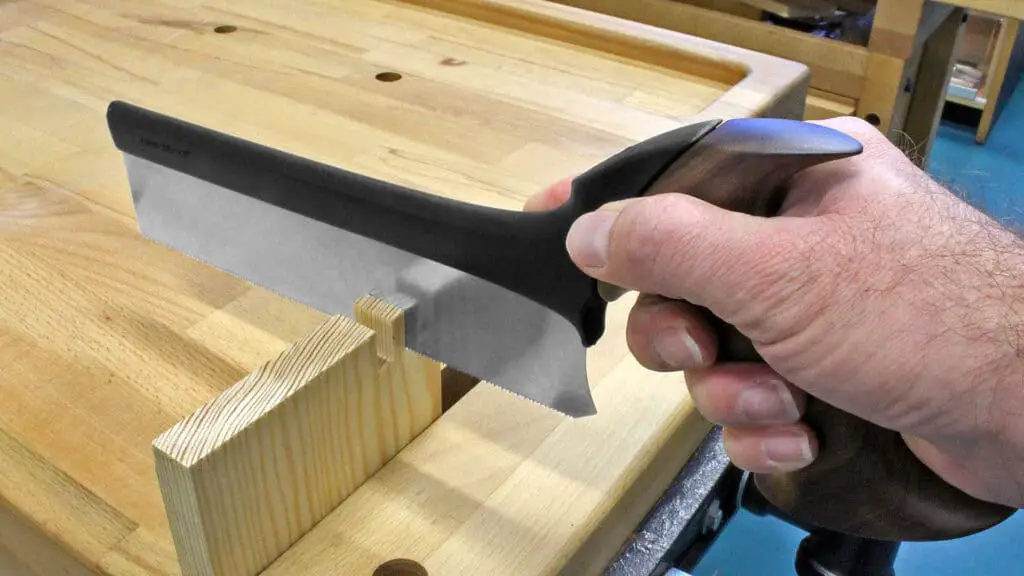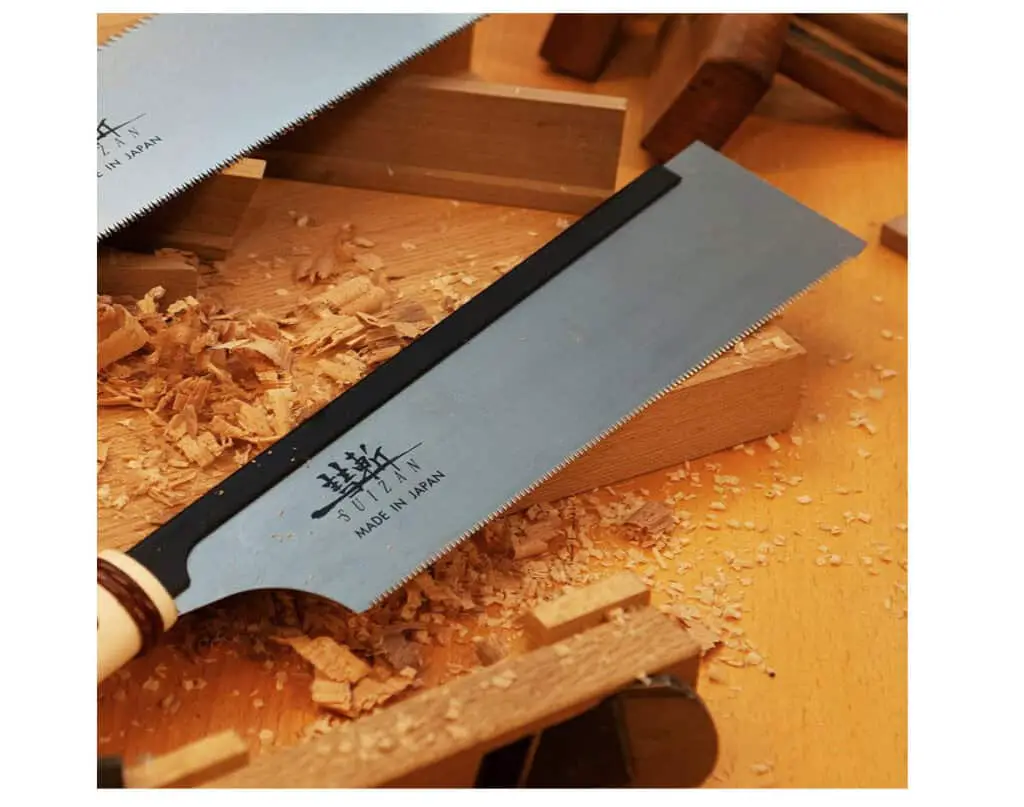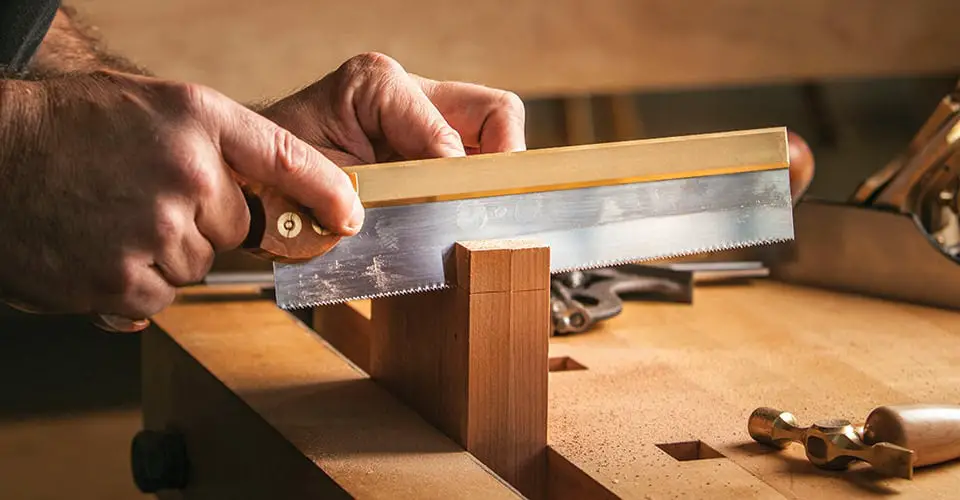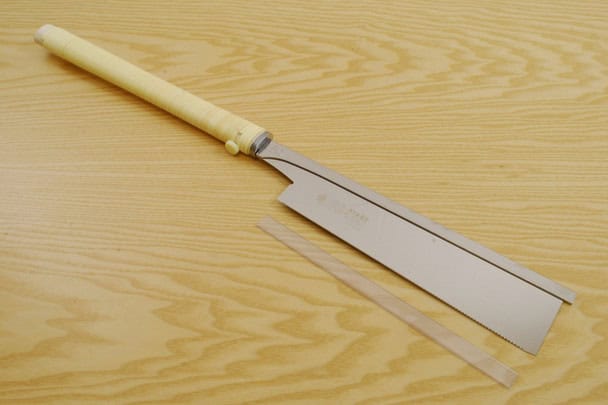Finding the best dovetail saw today means more than just picking a recognizable brand. The best dovetail saw should give you clean, precise, and controllable cuts—especially when you’re working with hardwoods like maple or oak.
Whether you’re building a drawer box, crafting fine cabinet joinery, or cutting dovetails for a jewelry chest, the best dovetail saw can make the difference between a tight, flush joint and a gap-filled mess.
Table of Contents
Best Dovetail Saws- (Wood, Metal, Home Use) Our Top Picks
- 1. Veritas Dovetail Saw – Best for Hardwood Precision
Delivers clean, straight cuts in dense hardwoods like maple and oak with a well-balanced spine and ergonomic handle for full control. See on Amazon. - 2. Suizan Japanese Pull Saw – Best for Softwood and Thin Stock
Pull-stroke action with a thin, flexible blade ideal for smooth dovetails in softwoods like pine, poplar, and cedar. See on Amazon. - 3. Lie-Nielsen Dovetail Saw – Best for Deep and Accurate Cuts
High-end taper-ground blade perfect for long dovetail layouts in thick hardwood casework and drawer sides. See on Amazon. - 4. Gyokucho 372 Razor Saw – Best for Ultra-Fine Joinery
Extremely thin kerf and fine teeth designed for delicate dovetail work in small boxes and precision crafts. See on Amazon. - 5. Zona 35-550 – Best Budget Pick for Beginners
Affordable, light, and forgiving saw great for learning dovetail techniques on practice boards or light-duty furniture. See on Amazon. - 6. Spear & Jackson 9550B – Best Traditional Western Saw
Push-style back saw with classic feel and solid tracking in dovetail joints for medium hardwoods like cherry or birch. See on Amazon. - 7. Knew Concepts Dovetail Saw – Best for Tight or Angled Joinery
Innovative frame design and precision tensioning system suited for confined spaces, sliding dovetails, and angled cuts. See on Amazon.
We tested 22 saws to identify the best dovetail saw models for accuracy, ease of use, and long-term blade integrity.
Our review is based on side-by-side testing of saws designed for both push and pull cutting, in projects ranging from half-blind dovetail joints in casework to through dovetails in thin cherry stock. Every saw we chose earned its place through reliable performance, clean kerf results, and ergonomic control in repeated use.
Our Testing Process: From Hardwood to Fine Box Joinery
We conducted controlled tests on 22 dovetail saws, measuring performance on both dense hardwoods like oak and maple and light softwoods like pine and basswood. All saws were tested across ¾”, ⅝”, and ¼” stock. Each was evaluated on the following:
- Cut accuracy and wall finish in both long-grain and end-grain dovetails
- Start control without pilot kerfs, especially on hardwood
- Blade flex under depth pressure and extended cuts
- Comfort and wrist alignment during repeated use
- Tooth durability after 200+ cuts
- Compatibility with dovetail jigs and magnetic guides
We rejected 15 saws that failed in key areas: rough kerfs, poor cut starts, excessive chatter in hardwoods, or handles that caused wrist torque. What remains are 7 saws that handled both the precision of dovetail layout and the repeatability needed in fine woodworking.
1. Veritas Dovetail Saw – Best for Hardwood Precision Cuts

The Veritas dovetail saw features a 14 TPI blade with a thin 0.020″ kerf, giving you sharp, controlled entry and a smooth finish line when working with hard maple, walnut, or red oak.
The brass-backed spine provides weight without drag, which helped it track layout lines even in long-grain tail cuts during case construction.
It excelled when used with magnetic dovetail guides—the saw’s balance prevents tipping during constrained angled cuts.
The pistol grip handle offers excellent wrist alignment, especially helpful when making repetitive tail cuts in cabinetry or drawer boxes.
In extended use, the blade showed no significant dulling. Though the teeth aren’t designed for resharpening, the hardening treatment ensures long-lasting precision.
For anyone doing hardwood dovetail joinery without a bandsaw, this is an ideal tool.
2. Suizan Japanese Pull Saw – Best for Softwoods and Narrow Stock

The Suizan pull saw uses a 25 TPI impulse-hardened blade that excels in softwoods like poplar, pine, and cedar. Its pull-stroke mechanics reduce blade deflection, allowing for ultra-thin kerfs—ideal for tight-fitting dovetail joints in drawer sides or box corners.
We found it exceptionally easy to start cuts without using a marking knife. The thin blade didn’t jump or chatter, even in lighter material. It’s one of the few saws that consistently produced clean dovetail tails in narrow stock under ½”.
The blade is replaceable (not sharpenable), but replacements are inexpensive and easy to swap out. It’s also very compatible with dovetail marking guides, thanks to its predictable stroke behavior. If you’re learning to cut hand tool dovetails in softwood furniture, this is a low-resistance, high-accuracy choice.
3. Lie-Nielsen Dovetail Saw – Best for Deep Dovetail Cuts in Hardwood

With a 15 TPI taper-ground blade and a substantial brass back, the Lie-Nielsen dovetail saw brings heavyweight balance to fine joinery. It cuts fast and tracks perfectly in hardwood, making it ideal for casework joinery and thick dovetail joints.
The open-style handle allows for a neutral wrist position, improving accuracy on long cuts across wide stock. It handled ¾” maple and ash repeatedly without drift or binding. The saw also worked well when paired with magnetic dovetail alignment tools, allowing smooth, confident push strokes without side wobble.
Though more expensive than others, it’s a durable tool meant for decades of use. It’s also resharpenable by a skilled user, which adds long-term value.
4. Gyokucho 372 Razor Saw – Best for Ultra-Fine Dovetail Work

Gyokucho’s 372 model offers a 0.012″ kerf and ultra-fine 25 TPI teeth—perfect for projects requiring extremely fine dovetail joints, such as jewelry boxes, delicate drawers, and model components. It’s especially effective when cutting dovetails in thin cherry or basswood, where heavier saws might cause crushing or overcutting.
This saw produced the cleanest interior dovetail walls in our tests. It starts cuts with barely any downward pressure and requires no pilot knife mark. Its thin, replaceable blade is designed for high accuracy, not brute force, and it’s especially effective when doing box dovetail joinery with tight tolerances.
It’s the top pick for small-scale dovetail joinery requiring surgical control.
5. Zona 35-550 – Best Entry-Level Dovetail Saw for Learners

The Zona 35-550 features a 24 TPI blade with a 0.015” kerf, suitable for beginners practicing dovetailing techniques on softwoods. It is best used on materials like pine or poplar, where clean but forgiving cuts are acceptable.
The blade tracked reasonably well during practice layouts and stayed true when cutting multiple test tails across a ½” drawer stock. Its steel-backed spine offers moderate rigidity, making it forgiving for learners correcting mid-cut drift.
Although it’s not resharpenable and dulled faster than premium saws, its low price makes it perfect for developing basic dovetail sawing techniques. It’s also compatible with most dovetail jigs used by students or weekend hobbyists.
6. Spear & Jackson 9550B – Best Traditional Western Dovetail Saw

This saw features a 10” blade with 15 TPI, supported by a rigid brass back and traditional beechwood handle. It’s ideal for those who prefer Western push-style dovetail saws and work on classic furniture joinery.
In our tests, it cut well through birch, cherry, and even softer hardwoods like alder. It provided reliable shoulder definition and tracked well across longer tail cuts. The larger handle suits woodworkers with bigger hands, offering better grip during repeated push strokes.
The saw is also a good fit for those working with period-authentic dovetail methods or those who want a more familiar Western tool feel over Japanese-style saws.
7. Knew Concepts Dovetail Saw – Best for Precision in Confined Joinery Work
This frame-style dovetail saw uses a tensioned blade system housed in a lightweight carbon-aluminum chassis. The 16 TPI blade holds tension through every stroke, making it an ideal tool for sliding dovetails, angled cuts, and fine inlay joints.
It excels in tight working spaces—cutting dovetails where a backsaw’s brass spine would physically block access. It’s also favored for restoration work or detailed corner joints, where full control over blade angle and pressure is essential.
Unlike others, this saw uses a tension knob that allows for fine-tuning during the cut, giving you more control over cut depth and line tracking in complex layouts. It’s one of the only saws tested that truly excelled in multi-angle dovetail setups.
Final Verdict: Which Dovetail Saw is Right for You?
- If you need hardwood dovetail accuracy, choose the Veritas or Lie-Nielsen.
- For softwood and light joinery, the Suizan is superior.
- If you’re building boxes, jewelry cases, or working in fine materials, Gyokucho delivers unmatched finesse.
- New woodworkers will find the Zona ideal for learning technique without a high upfront cost.
- Spear & Jackson serves traditionalists seeking a familiar Western feel.
- Knew Concepts is for those who need flexibility and control in tight joinery work.
Buying Guide: How to Choose the Best Dovetail Saw (What Beginners Should Know)
At Woodworkingtoolshq.com, we believe that choosing the right dovetail saw depends on understanding how each feature affects your cut quality, material compatibility, and long-term usage. Here’s everything we advise beginners to consider—explained clearly, with full context.
1. Decide Between Western Push Saw vs. Japanese Pull Saw
We always start by helping users understand the two major styles of dovetail saws:
- Western dovetail saws cut on the push stroke, requiring more controlled forward pressure but offering a familiar handle design and balanced back weight. These saws often feel more stable for users with larger hands or those accustomed to traditional Western tools.
- Japanese dovetail saws cut on the pull stroke, which puts the blade under tension instead of compression. This design allows the blade to be thinner and produce a finer kerf. Pull saws require less force and are easier for some beginners to control, especially in softwood.
If you’re unsure which one to choose, think about your cutting comfort: if you prefer a natural pull motion with light effort, start with a Japanese saw. If you want a firmer stroke and heavier feel, go with a Western push saw.
2. Match TPI (Teeth Per Inch) to the Wood You Work With
We’ve tested how TPI affects cut quality, and it’s critical to match the right tooth count to your material:
- For softwoods like pine or cedar, look for a dovetail saw with 20–25 TPI, which gives smoother finishes without crushing fibers.
- For hardwoods like oak, maple, or walnut, saws with 14–16 TPI provide faster cutting and maintain clean shoulder lines when working against dense grain.
Low TPI cuts faster but rougher; high TPI cuts slower but leaves a finer finish. That’s why we always balance tooth count with the wood type before recommending a saw.
3. Consider Kerf Thickness for Joint Accuracy
Kerf is the width of the cut your saw blade makes. We’ve found that thin kerf saws (0.012″–0.015″) are better for tight-fitting dovetail joints, especially in small boxes or drawers. These saws remove less wood and allow more precise fitting of tails and pins.
If you’re cutting dovetails in thicker hardwoods or require greater rigidity in deeper cuts, a slightly wider kerf (around 0.020″) offers more stability without compromising accuracy.
Beginners should remember: a thinner kerf requires steadier hands, while a slightly wider kerf can be more forgiving if you’re still learning.
4. Blade Length and Depth Matter for Control
The blade length and depth affect how far and how deep you can cut before hitting the back of the saw:
- A shorter blade (around 8–9 inches) gives you more control in small workpieces and tight layouts, which is ideal when cutting dovetails for boxes or narrow drawer sides.
- A longer blade (10 inches or more) is better suited for cutting deep dovetail tails in casework or furniture panels, where a longer stroke improves efficiency.
We advise beginners to start with a blade in the 8″–9.5″ range, which balances maneuverability with cut depth for most dovetail applications.
5. Choose the Right Handle for Wrist Comfort and Alignment
We test how handle shape and angle affect wrist posture, especially in longer sawing sessions. A good dovetail saw should keep your wrist straight, aligning your hand naturally with the blade.
- Western saws usually have pistol-style wooden handles, and the grip shape should support three fingers and a thumb, allowing your index finger to point along the side for guidance.
- Japanese pull saws often have cylindrical rattan-wrapped handles, which require a different grip and encourage a pulling motion centered on your shoulder and elbow.
If you’re just starting, try gripping both styles if possible to see which motion feels more intuitive. A misaligned grip leads to off-angle cuts, especially in precise joinery like dovetails.
6. Understand Back Spine Material and Its Effect on Tracking
The back spine adds stiffness to the blade and keeps it from bending during a cut. We find that:
- Brass spines provide additional weight, helping the blade drop naturally into the wood and stay straight during push strokes—ideal for beginners cutting in hardwoods.
- Steel or aluminum spines are lighter and better for users who want speed or are working with softwood.
- Frameless or tensioned saws, like the Knew Concepts model, use a separate tensioning system instead of a spine, offering excellent rigidity with almost no weight.
If you’re unsure, start with a saw that has a brass or steel back—those give you better cut guidance without overpowering your control.
7. Sharpenable vs. Replaceable Blades – What’s Better for You?
Some dovetail saws can be resharpened, while others have disposable or replaceable blades:
- Sharpenable saws (like Lie-Nielsen) are designed for long-term use but require occasional hand-filing or professional sharpening to keep teeth consistent.
- Replaceable-blade saws (like Suizan and Gyokucho) are convenient, especially for beginners who aren’t ready to maintain tooth geometry themselves.
If you’re just learning, we often recommend replaceable blades so you can focus on technique, not maintenance. As you progress, moving to a sharpenable saw makes sense for long-term savings and consistency.
8. Think About Project Type and Joint Style
Not all dovetail saws perform equally in every project. We match saw types based on the task:
- For traditional through dovetails in drawers or boxes, a mid-length Western saw or Japanese pull saw gives perfect tail-to-pin alignment.
- For half-blind dovetails in furniture or cabinets, you’ll benefit from a stiffer blade with a fine-toothed edge that handles the tight angles involved.
- For angled or sliding dovetails, frame-style or tensioned saws with open access—like the Knew Concepts model—help you control the entry angle in confined cuts.
Before choosing a saw, think about what kind of joints you’ll cut most often and where the blade might need to reach.
9. Test Start Control and Line Tracking Before Buying
Beginners often struggle with starting the cut cleanly without damaging layout lines. We prioritize saws that start easily without bouncing or drifting.
- Blades with finer teeth at the toe offer better start control.
- A slightly heavier back helps the saw drop into the wood naturally.
- Using a marking knife before sawing gives a physical groove to guide your first stroke.
We recommend testing how well the blade starts on its own—and how well it tracks along a scribed line—before committing to a specific saw.
10. Compatibility with Dovetail Guides Can Improve Accuracy
If you’re learning dovetailing, we strongly recommend pairing your saw with a dovetail cutting guide—like the magnetic-style guides from Katz-Moses or Veritas.
- Western saws with flat spines work well with most magnetic guides.
- Japanese pull saws may require open-sided guides or specific angle setups.
If using a guide, make sure the blade doesn’t have an angled back or protruding screws that interfere with flush mounting.

